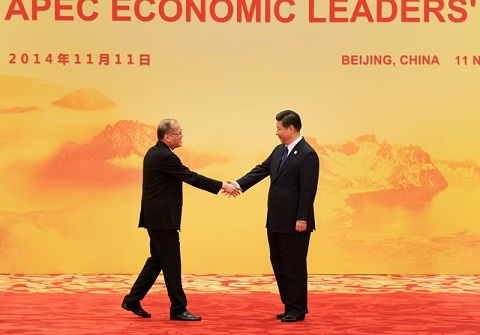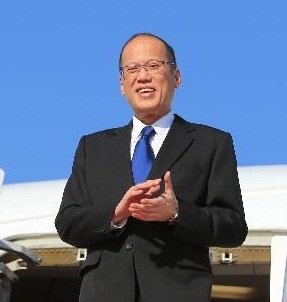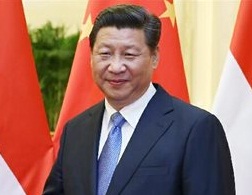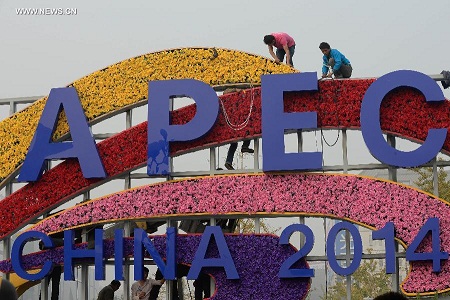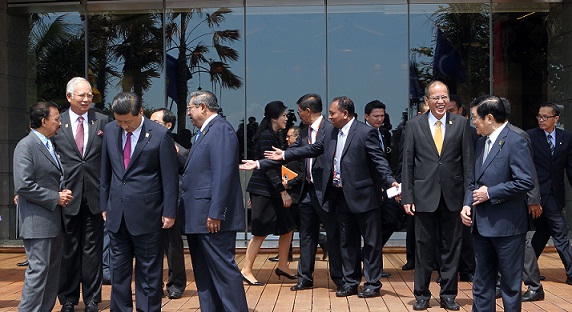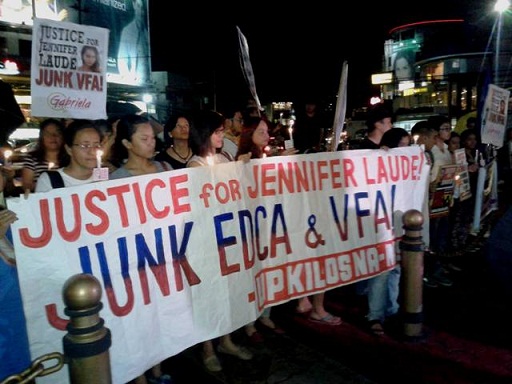It took only ten minutes under the chilly air at the lakeside garden in the suburb of Beijing to thaw the two-year frosty relationship between the Philippines and China.
President Aquino and Chinese President Xi Jinping pulled aside during the tree-planting ceremony last Nov. 11 at at the Summer Garden of the International Conference Center at Yanqi Lake, where 21 leaders of the Asia pacific Economic Cooperation (APEC) met the day before, talked briefly, both expressing the desire for relations between their the two countries to improve from a severely strained connection that it is now.
Aquino described the 10-minute talk which was pre-arranged (they did not have a formal meeting which usually lasts 25 to 30 minutes) as “Medyo extensive” reflecting the importance he attached to it and what the brief meeting achieved.
“We are very happy in the sense that it’s the first time that we’ve had—well, number one—direct contact with them after I met with President Hu Jintao previously (2011). So it’s a nice opening. Hopefully, it will lead to something concrete, ” Aquino said in Myanmar, where he directly proceeded from Beijing for the 25th summit of the 10-member Association of Southeast Asian.
Asked for details of the talk, Aquino referred to the press release of China on the meeting. A Xinhua story on the meeting said “President Xi Jinping said Tuesday that China expects the Philippines to return to previous bilateral consensus and handle relevant disputes in a constructive way.”
On his part, Aquino said, “We are looking… for constructive ways. I emphasized our primary function, and we presumed their government’s primary function, is to improve their people’s lot or lot in life. So parang I emphasized na any dispute, any conflict does not enhance our ability to parang concentrate on improving the lot of our people, so may agreement naman doon.
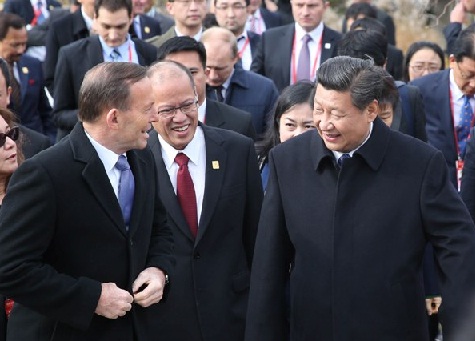
President Benigno S. Aquino III shares a light moment with Chinese President Xi Jinping and Commonwealth of Australia Prime Minister Tony Abbott during the 22nd Apec Leaders’ Meeting Tree Planting Ceremony at the Summer Garden of the International Conference Center at Yanqui Lake here on Tuesday (November 11). (Photo by Ryan Lim/ Malacañang Photo Bureau)
Aquino said they did not discuss the case filed by the Philippines before the United Nations Arbitral Tribunal questioning the legality of China’s nine-dashed line map that encompasses parts of other countries in Southeast Asia including the Philippines.
The U.N. complaint, the first filed by any country against China, has strained relations between the two countries spilling beyond territorial dispute to trade, economic, and tourism issues.
The Aquino –Xi talk augurs well for Philippine-China relations, which is at a low ebb, probably the lowest in its 39-year history.
But so many things have happened in the past two tumultuous years between the two neighbors that would not be easy resolve Aside from the U.N. case, there’s China’s control of Scarborough shoal, also known as Panatag shoal or Bajo de Masinloc (China calls it Huangyan Island) in Zambales.
Having lost Scarborough Shoal to the Chinese is a stigma that Aquino would not want attached to his administration. In fact, that triggered the filing of the case before the U.N. Arbitral Court.
There’s also the Philippine Marines outpost in a grounded Navy Ship in Ayungin Shoal (China calls it Ren’ai reef) 105.77 nautical miles from Palawan but just 21 nautical miles from Chinese- occupied Mischief Reef.
Chinese officials have protested many times the presence of Filipino soldiers in the reef.
Does Aquino now agree to bilateral talks with China which was what Xi proposed (“ previous bilateral consensus”) and which the Department of Foreign Affairs under Foreign Secretary Albert del Rosario has shunned insisting instead on multilateral dialogue involving ASEAN or other South China Sea claimant countries?
If so, that would be a major foreign policy shift for the Philippines.
The thaw in PH-China relations has become immediately evident with the clarification by the Chinese Embassy in Manila that the Philippines is not excluded in the US$40 billion 21st century maritime Silk Road initiative, which would connect Asia Pacific and Europe, contrary to a Wall Street Journal report that China bypassed the Philippines as punishment for hauling the economic superpower to the U.N. court.
The Chinese Embassy in its statement yesterday said: “The media report of ‘’China bypassing Philippines in its 21st century maritime silk road” is incorrect.
“ China has never published any official map of the 21st century maritime silk road, nor has China excluded the Philippines from the blueprint of the 21st century maritime silk road.
“The ancient maritime silk road had long been an important route of economic and cultural exchanges between east and west. In October 2013, Chinese President Xi Jinping put forward the initiative of building a 21st century maritime silk road during his visit to Indonesia. Based on historic traditions, this strategic concept is aimed at deepening China’s friendly cooperation with the world by promoting policy communication, road connectivity, trade facilitation, monetary circulation, and people-to-people exchanges along the route, thus leading to a more closed community of shared destinies.
“On November 8th 2014, Chinese President Xi Jinping announced that China will contribute US$40 billion to set up a Silk Road infrastructure fund, which will bring new opportunities for infrastructure, resources and industrial development along the 21st century maritime silk road.
“Since ancient times, the trade, cultural and personnel exchanges between China and the Philippines have been conducted on the sea with a history of more than a millennium. The Philippines is definitely part of the 21st century maritime silk road, as well as a member of the China-ASEAN maritime cooperation.
“China welcomes the Philippines to be a proactive and constructive partner of the 21st century maritime silk road, which serves the national interests of the Philippines and will contribute to the social and economic development of the Philippines.”
Indeed, things are warming up between China and the Philippines.
